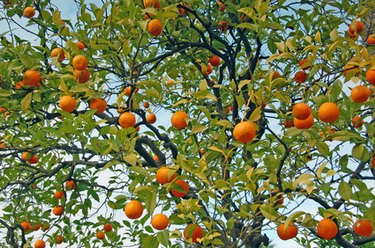Things You'll Need
Ammonium sulfate
Water soluble fertilizer
Large container with holes in the bottom
Pruning shears

Tangerines are among the most popular citrus fruit varieties. Tangerine trees are also rising in popularity for both indoor and outdoor home growth. Their beautiful, fragrant blossoms, deep green leaves and bright fruit add flair to yards and warmth to indoor spaces. While it is generally thought that citrus fruits can only be grown outdoors in warm regions, with proper care tangerine trees can produce fruit indoors.
Outdoor Care
Step 1
Water the tangerine tree. Mature and established trees should be watered deeply every two weeks unless your soil is very sandy, in which case more frequent watering is desirable. Julian W. Sauls, professor and extension horticulturist with Texas A&M AgriLife, says that mulching is not recommended for citrus trees.
Video of the Day
Step 2
Fertilize the tree. Young tangerine trees should be fertilized during the first year of life. Split 1 cup of ammonium sulfate into three or four applications. Apply it to your tangerine tree every few months. As the tangerine tree gets older, add 1 cup of ammonium sulfate per year. For example, a 3-year-old tree should receive 3 cups of ammonium sulfate divided over the year. Scatter the fertilizer near the tree and water so it is washed toward the tree.
Step 3
Protect the tangerine tree from cold. When frost threatens, cover the tree in a blanket or similar material. If necessary, place a heat lamp or incandescent bulb under the cover to keep the tree warm. The only time pruning is required for tangerine trees is in the case of cold damage, in which case weak branches should be cut back or removed.
Container Care
Step 1
Choose a container for the tangerine tree with proper drainage and size. The container should have holes in the bottom and be large enough to let the tree grow freely while also being easy to transport between indoor and outdoor settings when necessary.
Step 2
Place the tangerine tree in a location that receives bright sunlight in the morning and shade in the afternoon. Container tangerine trees need partial shade to control their growth. Keeping them in a partially shaded location outdoors will also help them acclimate better when they're brought indoors during cold weather. If you expose your tangerine tree to low light for an extended time period, the tree will be spindly and less lush.
Step 3
Water the tree. Allow the top inch of soil to dry out between waterings. Water the tree deeply and slowly until water comes out of the bottom of the container. Water the tree less during the winter months.
Step 4
Fertilize the tangerine tree. Use a water-soluble fertilizer and follow the directions on the product. If your tree appears spindly, you may be overfertilizing. If its leaves are pale green, it may not be receiving enough fertilizer.
Step 5
Prune the tree. While outdoor trees do not require pruning, indoor trees will become thin without adequate light. If this occurs, cut back the top branches by one-third of their length. This will encourage your tree to grow new branches and become bushy. Your tree still should be placed in brighter light to thrive. February is a good time to prune as it will not interfere with new blooms or fruit.
Tip
Move containers indoors in winter and before a freeze. If your tree has been outdoors all summer, acclimate it to its indoor environment by placing the tangerine tree in partial shade for two weeks before bringing it indoors. When you move your tree outdoors again, reacclimate it to sunlight by gradually increasing sun exposure.
Video of the Day